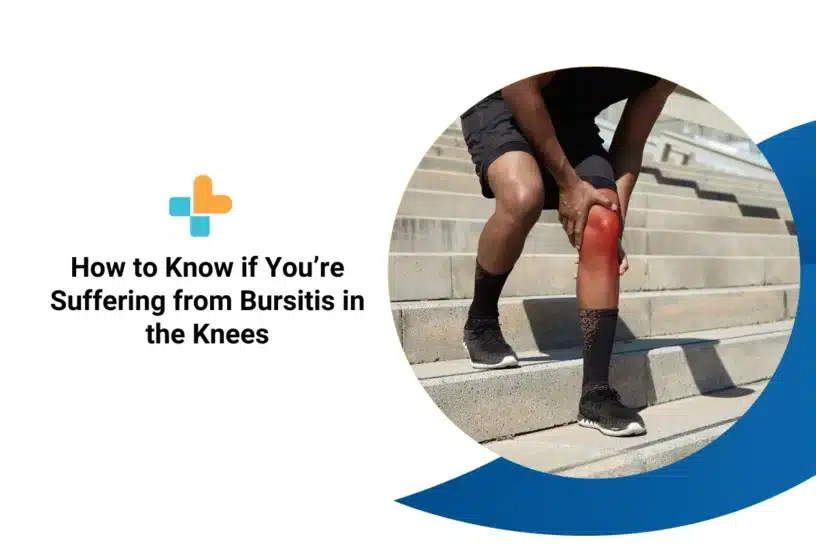Are you experiencing knee pain that won’t go away? It might be more than just a temporary discomfort. You might be suffering from a common condition called knee bursitis.
Recognizing the symptoms early on is crucial for timely intervention and effective treatment. A study by NIH shows that yearly, at least 1 out of 10,000 people develop bursitis on the knees alone.
This blog will explore the symptoms, risk factors, and treatment options for knee bursitis.
Understanding the Function of Knee Bursae
Knee bursae are small fluid-filled sacs located around the knee joint. Their primary function is cushioning and reducing friction between bones, tendons, and muscles.
These sacs act as protective cushions, allowing smooth movement and preventing irritation.
By reducing the friction caused by repetitive movements or pressure, bursae help maintain the knee joint’s overall health.
Recognizing the Signs and Symptoms
Recognizing the signs and symptoms of bursitis in the knees is key to seeking appropriate treatment. The following are some common indicators to watch out for:
- Pain and tenderness: You may experience localized pain around the affected knee, which can worsen with movement or pressure.
- Swelling and inflammation: The knee area may appear swollen, accompanied by redness and warmth.
- Limited range of motion: Bursitis can restrict your ability to bend or straighten your knee fully.
Identifying Risk Factors
Recognizing the risk factors associated with knee bursitis is essential for understanding how to prevent its occurrence. The following are some key factors to consider:
- Repetitive stress or Overuse: Activities involving repetitive knee movements or strain increase the risk.
- Trauma or Injury: Previous knee injuries, falls, or direct blows can make the bursae more prone to inflammation.
- Certain Occupations or Activities: Work with prolonged kneeling or sports involving frequent kneeling or direct knee impact elevates the risk.
Diagnosing Knee Bursitis
Accurate diagnosis of knee bursitis involves a thorough evaluation of symptoms, physical examination, and, if necessary, diagnostic tests. The following are the key steps in diagnosing knee bursitis.
- Evaluation of medical history and symptoms
- Physical examination for signs of inflammation and tenderness
- Diagnostic tests like X-rays or MRI scans to rule out other causes
With a confirmed diagnosis, let’s explore the available treatment for knee bursitis.
Also Read : How To Prevent Knee Pain in Old Age
Treatment Options
When treating knee bursitis, there are several approaches depending on the severity. From conservative measures to more advanced interventions, the following are treatment options for knee bursitis.
Conservative Treatment Methods
- Rest and activity modification
- Ice and compression
- Nonsteroidal anti-inflammatory drugs (NSAIDs)
In case more intensive treatment is required, your doctor may consider:
- Physical therapy and targeted exercises
- Corticosteroid injections
- Aspiration or drainage of the bursa (rare cases)
Preventive Measures
Taking proactive steps can help prevent the causes of knee bursitis and promote healthy knees. The following preventive measures you can consider:
- Warm up and Stretch: Prioritize proper warm-up and stretching exercises before physical activities.
- Maintain a Healthy Body Weight: Manage your weight to reduce knee strain.
- Use Protective Padding or Equipment: Employ knee pads or other protective gear during activities that stress the knees.
Now, let’s explore when seeking medical consultation with a doctor for knee bursitis is essential.
When to Seek Medical Help
Recognizing when to seek medical assistance for knee bursitis is crucial to ensure proper diagnosis and timely treatment. The following signs indicate it’s time to consult a healthcare professional:
- Worsening or persistent pain and swelling, despite self-care measures.
- Severe limitation of movement or difficulty in performing daily activities.
- Warmth, redness, or signs of infection in the affected area.
Expert Care for an Active, Pain-Free Lifestyle
Recognizing the signs of knee bursitis and seeking timely treatment can significantly affect your joint health and overall quality of life. Prevention is key, so take proactive steps to protect your knees and minimize the risk of developing bursitis.
If you’re experiencing knee pain or need guidance on managing bursitis, Ayu Health is here to help. Our dedicated professionals offer expert care to ensure a pain-free, active lifestyle.
Choose Ayu Health and prioritize your knee health for a better tomorrow.
Our Hospital Locations
Orthopaedics Surgery Hospitals in Chandigarh | Orthopaedics Surgery Hospitals in Bangalore | Orthopaedics Surgery Hospitals in Jaipur | Orthopaedics Surgery Hospitals in NCR | Orthopaedics Surgery Hospitals in Hyderabad
Our Doctors
Orthopaedics Surgery Doctors in Chandigarh | Orthopaedics Surgery Doctors in Bangalore | Orthopaedics Surgery Doctors in Jaipur | Orthopaedics Surgery Doctors in NCR | Orthopaedics Surgery Doctors in Hyderabad
Resources:
https://www.ncbi.nlm.nih.gov/pmc/articles/PMC3354353/
https://www.webmd.com/pain-management/knee-pain/knee-bursitis-treatments




